a wool poncho and a working sleep system
2017-05-30
I've tried the alpaca sleepingbag in cold temperatures. I was always fine, but it never felt warm and cozy. To remedy this I'd been thinking of adding an alpaca blanket to the inside. Angie and I were wandering around a small town in Colorado recently and tripped over something even better, a wool poncho, made of a very soft and not very allergenic wool.
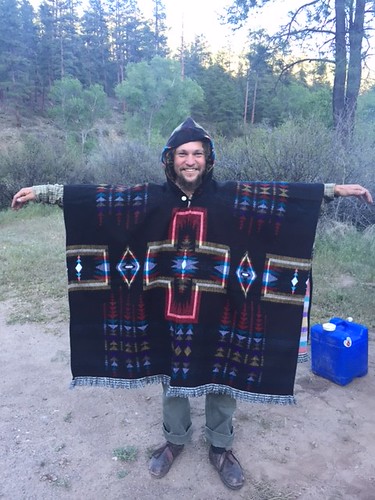
I've been testing wearing it on cold mornings and evenings, and discovered that, layered with my 320 weight marino icebreaker sweater (thanks mom!), it's warm enough to hang out in the 40 degree range. For shorter periods, such as cooking breakfast or dinner while backpacking it's warm enough to deal with ~20F. It's best if I tie a cord around the waist, particularly if it's windy.
This means it's sufficient to fill the roll of a "puffy", that is the down or synthetic filled jacket most backpackers wear on chill mornings and evenings, or during lunch on a windy peak. You can't layer a rain-coat over it, but a down can't be worn in the rain much either. I've been using a second sweater to fill this roll, but this if anything a little nicer.
Okay, so it works as a jacket, how about the original goal as part of my sleep system, for use as a "liner" inside my alpaca sleepingbag?
We were near Creede Colorado and went looking for a campsite down some local 4x4 roads. I decided it was a perfect time to finally test using the poncho for sleeping. I pitched a tarp (800 threadcount untreated cotton) primarily for wind, but that night it hailed, then snowed. When I checked the thermometer a bit after first lite it read 23F.

Note that I've also removed the canvas from the alpaca sleepingbag to save weight, but sewed a small strip back on on the top and bottom for drawstrings. I also slept on a ground-cloth (just a very thin piece of worn canvas from a WWII army tent), but used no ground pad, and slept naked.
So, the results? I was warm and cozy. I mean really cozy, not just "It's not too bad". I would rate this system as similar to ~20F sleepingbag, which means it's good enough for most trips, even in the mountains or edge seasons. In the morning I checked the GPS on my phone and we'd been sleeping at ~11,000 feet! No wonder it snowed on us :P.
I'm really excited, I've finally found a non-plastic system that really works well for colder weather without having to have a fire all night long. I believe the wool acts like a "base layer" helping me *feel* warm, keeping larger air pockets away from direct contact with my skin, while the alpaca fur acts like a "puffy layer", providing the main insulation.
It adds a little weight, but since it can replace one of the 2 wool sweaters I've been using it's not that much. I don't know exactly though since I don't currently have access to a scale. I'm also excited to use this poncho as almost my only gear on super minimal summer bushcraft trips
As a bonus, it looks kind of cool... if you don't mind that "hippie" look ;-).
Climbing, falling is a skill
2017-05-10
I just recently completed my first outdoor 5.10 lead climb (sport). Woot! This was actually a 5.10a/b as it happened, admittedly a bit of a soft rating, but I'm going to crow a little anyway. Crossing in to 5.10's is a bit of a milestone, so I wanted to share the realization that finally pushed me over the threshold.
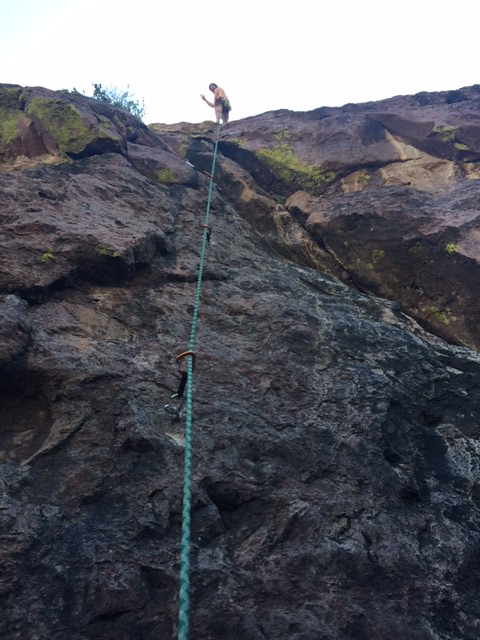
Most people learn climbing by climbing with experienced folks. I did this on my first few outdoor climbs way back ~2008/9 or so, but while on the road it hasn't been an option. As a result I'm largely self and book taught. This works, but there are some extra pitfalls involved.
In
http://www.blog.smalladventures.net/2016/06/my-first-trad-climb.html
I talked about my history. I was climbing in the 5.11 range toprope indoor around 2013. I didn't climb much between then and 2016 when Angie and I hit the road. 2013 and before a lot of people showed me trad placements, I took high-angle rescue courses, etc. As it notes there I dove in to trad lead before doing sport lead, like the people did back in the day before sport climbing was a thing, and for the same reason there wasn't sport where I was at the time. As a result I started by leading 5.4 trad climbs, working my way up to ~5.7 trad.
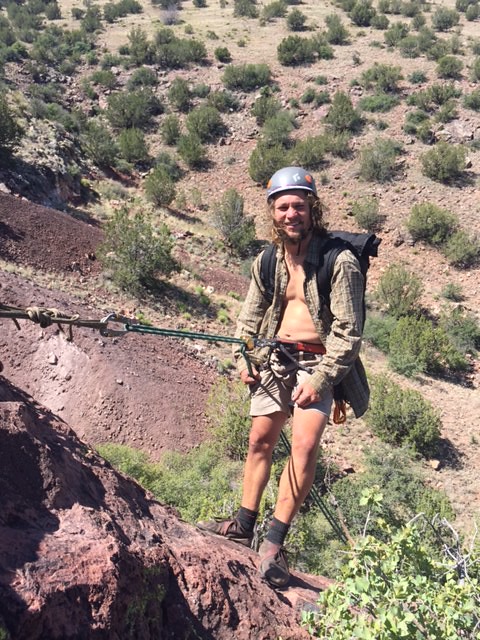
(Notice the klimbheist re
pell backup Angie and I usually use, it's compact, simple, smooth, doesn't tend to jam or melt, and makes edge transitions safe and easy)
Then we started hitting sport climbing, and I started leading 5.8's. Last fall we were climbing up in New Hampshire. I was leading my first 5.9. I accidentally climbed past a bolt. Angie not wanting to interrupt my concentration didn't yell at me that I was screwing up royally. Then I blew the move while heel-hooking a ledge... I ended up dropping ~25 feet flipping over in the process, the rope caught me fall slamming me upside-down against the rock on my back. My head impacted the rock HARD. Angie bruised up her knees pretty good catching her first major lead fall, but managed to suck up probably 5 feet or rope during my fall, saving me from an even bigger whipper. Luckily my back missed hitting anything pointy (say, a bolt) and I had a helmet on which got crushed by protected my head. I had a mild concussion, but besides replacing my helmet there were no other consequences.
Don't do that.
In contrast, on my recent 5.10 I felt pretty confident. I know I'm clipped in properly. I know that if I fall the rope will do it's job. And I know I know how to properly land the falls I was likely to take on that climb. What's the difference?
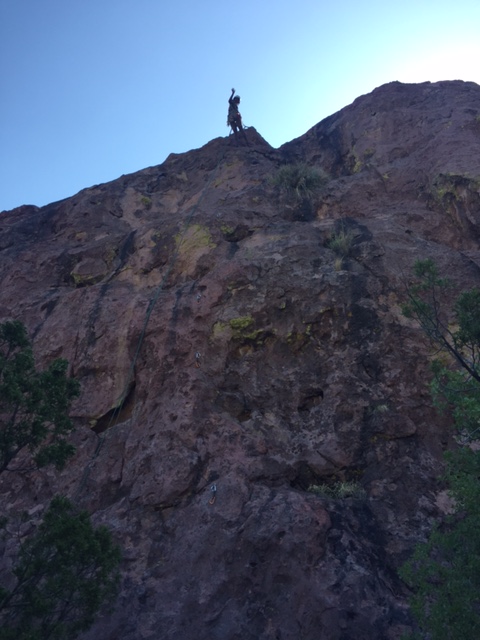
The difference is I took some practice falls. Experienced climbers are probably rolling their eyes going "Duh... idiot". Yeah, a bit, sometimes you miss the obvious stuff. For anyone else though: Start low, go up to say your second or third bolt (more rope out is better, of course), clip in, climb maybe a foot above it, and drop. Then do it from 2 feet, then with your feet above the bolt. Work up as you get comfortable.
I'd been climbing in the 5.8 range for a little while, recently while watching Angie climb lead I realized just how terrified she was of falling, and it occured to me that she needed to take some lead practice falls. As this thought passed through my mind I suddenly realized that I had the same problem. So, we took a few practice falls, not even that many, and suddenly literally the next day, She was leading 5.8's instead of 5.7's and I was leading 5.9's then a 5.10ab instead of 5.8... And we were doing it more safely!
Normally one does this when they get in to leading, but practice falls aren't an option in Trad, because every fall carries some non-trivial risk of equipment or rock failing. As a result I hadn't done it in the beginning, and I forgot to back and do it when we started climbing sport.
I'm excited, 'cause except for taking some rests, I climbed the 5.10ab clean, first try, no falls... which means it'd be reasonable for me to trad climb that route. I *should* be sport climbing above my trade level, so clearly my confidence and falling skills haven't yet caught up to my climbing ability. I'm excited to practice falling more and see where that takes me.
Next time I get on a sport wall, I'm going to take some more practice falls. I need to keep working up the runnout I'm comfortable handling. Eventually I want to practice falls (intentionally) equivalent to falling while clipping on a 15' spacing between bolts. Obviously this should be done with a lot of rope out, to keep the fall factor down.
Long story short, falling is a skill, practice it like one.
Linen Leggings
2017-05-06
Angie and I were talking about gear. A little while ago I picked up some linen suit pants at a goodwill for a couple of bucks. I tried hiking in them and decided they definitely wouldn't hold up for a long backpacking trip. But recently, Angie suggested I try making leggings/chaps out of them. Here's what I ended up with:

I haven't worn them hiking or anything yet, but they seem like they could definitely work. The idea was for hiking on the east coast, or in other areas during peak mosquito season. I want shorts for hot days (also common in mosquito season), but I want something to put on in the evenings. I've considered making "button-offs" like zipoffs, but using buttons... but this is definitely simpler.
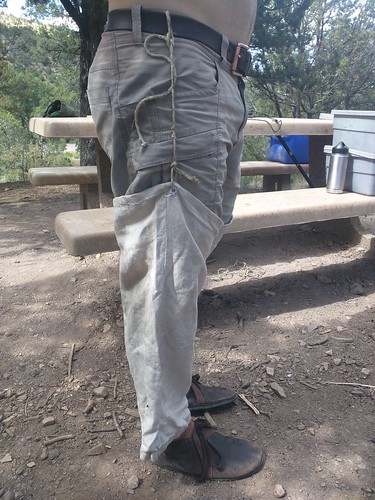
They remain untested to date though. As a bonus, they would work with a skirt as well, which I'm leaning towards more and more as I think about how to deal with really hot weather without nylon.
We'll see how they actually work out though!
I also finished my new food bag. It's made of lightly treated 800 threadcount sheet. The side is full-felled for strength, the bottom is double-seamed, and the top has 2 grommets and a seam. It can be used as a roll-top like a drysack or as a draw-type stuff-sack, the idea being that it'll carrying varying amounts of food well.
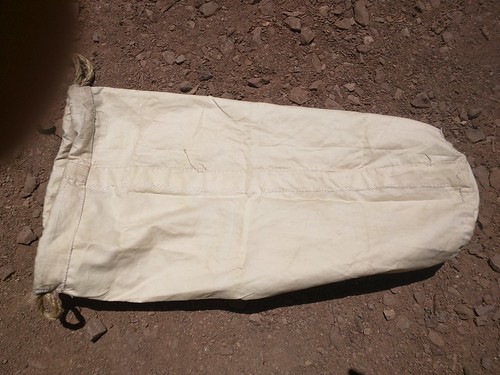
This was WAY more work than the linen leggings (over a day of sewing actually), as I wanted it to be very robust it's done with small tight stitching. But, fundamentally it's a bag, so not nearly as interesting :P.
Fire pit sleeping technique
2017-05-06
Angie and I went backpacking in the Gila National Forest in New Mexico. Getting out there was pretty intense... We cleared quite a few trees with the truck getting to the trailhead where we started.
We went backpacking with food for 4 days, unsure how things would go. We hiked down to the middle fork of the Gila, then down the river a couple of miles and slept on the beach. We quickly realized the going down the Gila was WAY too slow to make our original plans, so modified our loop to take a small canyon up and loop back around to some dirt roads.
Since we camped on the shore of the Gila both nights, there was plenty of sand. I was using my alpaca sleepingbag, and figured it was the perfect opportunity to finally try this technique I've read about so much.
First, I dug a pit about 6" deep. I would advise targetting 8", I'll explain why soon.

Then we lit a fire in the pit, and used it to cook our dinner, etc.

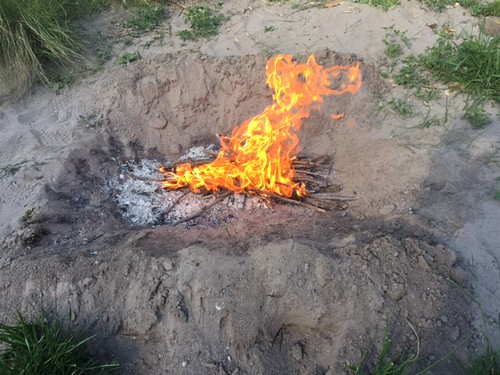
It was too dark when we put the fire out and buried it, so no good pictures there. But basically we kept it going until it was time to go to bed, then let it burn down to coals, and carefully buried it in the sand I have piled on the sides of the pit in these photos... making sure the coals didn't end up too far up in the sand.
Then, I curled up on it in my alpaca bag and went to sleep... it was very warm.
Partway though the night I had to shift a bit due to some hot-spots that were uncomfortably warm, and that I was afraid would damage the fur. The hot spots take a while to build up and reach peak temperature. This is the reason 8" would probably be better, you need a decent amount of material between you and the coals to distribute the heat properly. I had this problem both nights actually, as the second night I hadn't even planned to do this, and then I figured hey, we had a fire why not?
I will say though that it was very cozy, and was still warm come morning. In this way it was far superior to sleeping next to a fire, where you have to keep the firing going all night, and if you fall in to a deep sleep for several hours it's likely to be out when you wake up.
All in all I would definitely do this again, but digging the pit is hard, so it's a technique for loose ground only. Only useful sometimes, but a great strategy to have in your arsenal for dealing with using a little less gear.
Note: I did not use rocks in the pit, I figured sand is already rocks and would hold the heat, and rocks can sometimes explode. Rocks would help hold the heat if the pit were in loam, but in sand they just add unneeded risk.
Being Less Wasteful
2017-05-06
I post a lot about the gear I'm making here, but I don't talk as much about the gear I'm repairing.
Here's a pair of pants I juts repaired. Somehow a coal got on it and melted a hole through it (no damage to me). I patched it with the remntants of another old pair of pants. You can see the crotch has already been repaired in a similar manner (on the outside for chafing reasons though).
In this case the fabric has some plastic in it, so I finished the edge with fire, then whip-stitched around the edge to stitch it on, then around the hole as well. If the patch was all natural fibers (like one I did on my long-sleeve shirt recently), I would fold the edge inwards first. This is actually a lazy version of traditional sail patching techniques, where you would cut the old fabric fold it under and whip-stitch it as well.
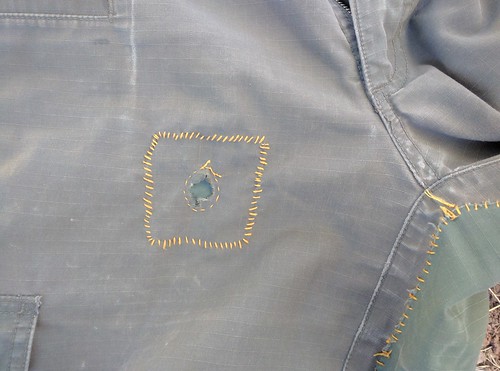
I've been wearing my buckskin shorts a lot more lately, and a couple of the seams started to open up a bit, I used an awl the work the stitching tighter and tie it off tighter again.
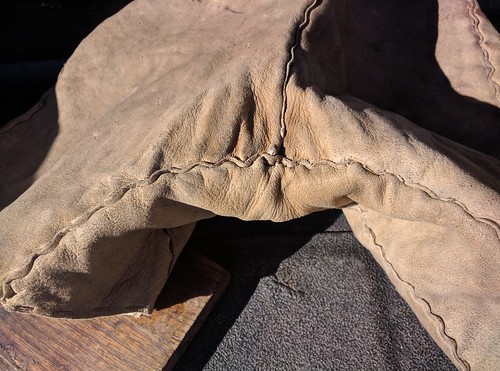
These are my climbing and running shorts, an old pair made of nylon. The rear pockets have been sewn back on, and the seam below the front zipper had already been restitched. This time I was restitching the crotch seam. The fabric on these seems to be holding up way better than the stitching, so Just keep sewing them back up again :P.
Note that the old repair is just a simple running stitch, but the seam I was repairing this time had been serged... I went with a blanket stitch to try and finish the edge of the fabric at the same time (at least I think that's a blanket stitch, I kind of made it up as I went).
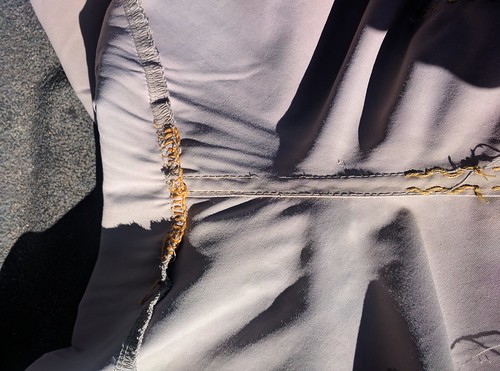
In a similar effort to be less wasteful and throw less stuff away Angie has been learning to shave her legs with my straight-razor (which she gave me for Christmas actually). I wanted it because it bugged me to throw away disposable razor blades, and because it doesn't jam up so badly when the hair is long. She started using it too for exactly the same reasons. We run it over the strop a few times after every use to keep it nice and sharp.
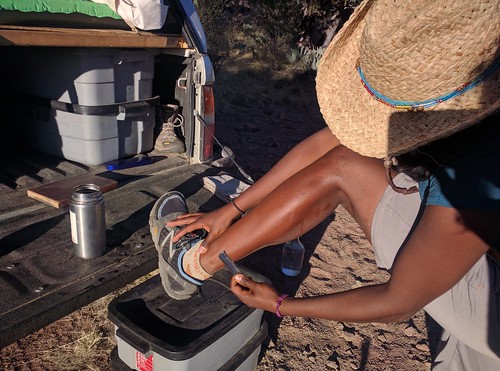
When you have fewer things, it's much more apparent that they wear out. If you have more things they wear out just as much, you just don't notice because the wear is distributed across so many different items. Angie and I hate how much trash we create (mostly from food packaging, actually), but try and reduce it where we can... also, it's a good way to save money so we can spend it on better things, like burgers in town.

